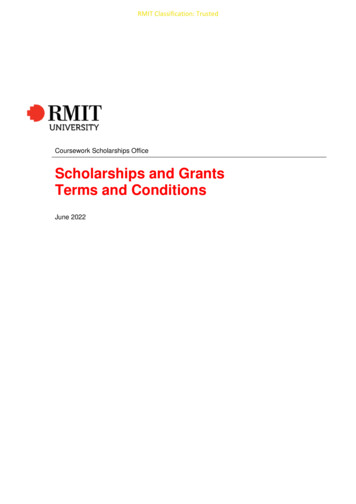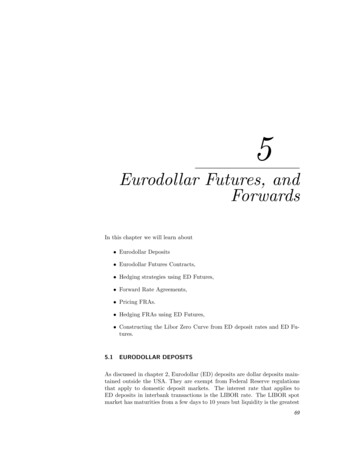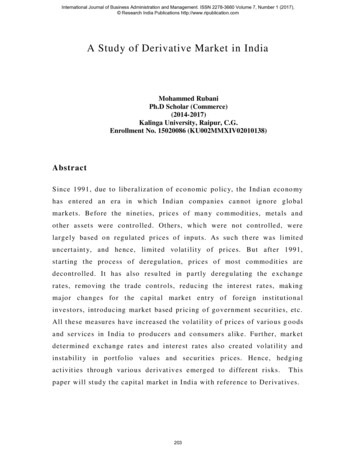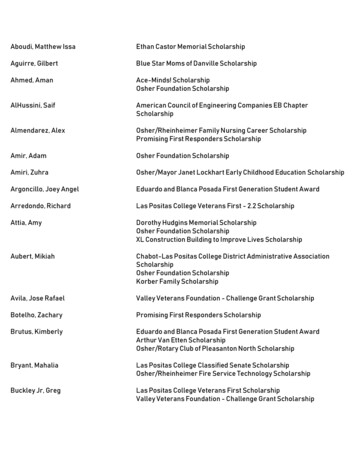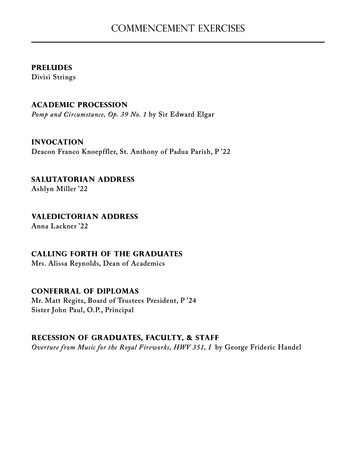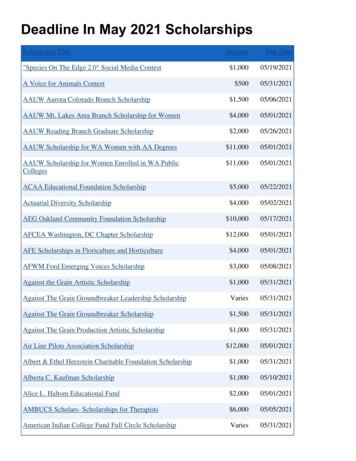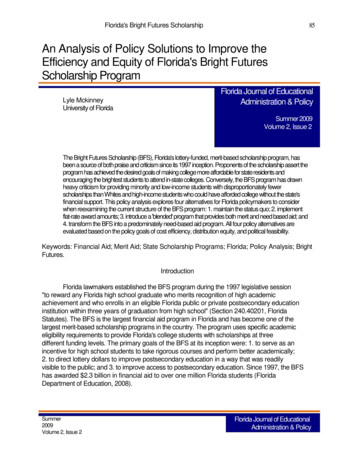
Transcription
Florida's Bright Futures Scholarship85An Analysis of Policy Solutions to Improve theEfficiency and Equity of Florida's Bright FuturesScholarship ProgramFlorida Journal of EducationalAdministration & PolicyLyle MckinneyUniversity of FloridaSummer 2009Volume 2, Issue 2The Bright Futures Scholarship (BFS), Florida's lottery-funded, merit-based scholarship program, hasbeen a source of both praise and criticism since its 1997 inception. Proponents of the scholarship assert theprogram has achieved the desired goals of making college more affordable for state residents andencouraging the brightest students to attend in-state colleges. Conversely, the BFS program has drawnheavy criticism for providing minority and low-income students with disproportionately fewerscholarships than Whites and high-income students who could have afforded college without the state'sfinancial support. This policy analysis explores four alternatives for Florida policymakers to considerwhen reexamining the current structure of the BFS program: 1. maintain the status quo; 2. implementflat-rate award amounts; 3. introduce a 'blended' program that provides both merit and need based aid; and4. transform the BFS into a predominately need-based aid program. All four policy alternatives areevaluated based on the policy goals of cost efficiency, distribution equity, and political feasibility.Keywords: Financial Aid; Merit Aid; State Scholarship Programs; Florida; Policy Analysis; BrightFutures.IntroductionFlorida lawmakers established the BFS program during the 1997 legislative session"to reward any Florida high school graduate who merits recognition of high academicachievement and who enrolls in an eligible Florida public or private postsecondary educationinstitution within three years of graduation from high school" (Section 240.40201, FloridaStatutes). The BFS is the largest financial aid program in Florida and has become one of thelargest merit-based scholarship programs in the country. The program uses specific academiceligibility requirements to provide Florida's college students with scholarships at threedifferent funding levels. The primary goals of the BFS at its inception were: 1. to serve as anincentive for high school students to take rigorous courses and perform better academically;2. to direct lottery dollars to improve postsecondary education in a way that was readilyvisible to the public; and 3. to improve access to postsecondary education. Since 1997, the BFShas awarded 2.3 billion in financial aid to over one million Florida students (FloridaDepartment of Education, 2008).Summer2009Volume 2, Issue 2Florida Journal of EducationalAdministration & Policy
Florida's Bright Futures Scholarship86While the BFS program's degree of success in achieving the three initial policy goalsoutlined by Florida legislators continues to be a source of intense debate amongpolicymakers and educational researchers, it is apparent that unintended and undesirableconsequences have emerged as a direct result of the policy's implementation. The primarycriticism of the BFS is the fact the program allocates the majority of the state's finite financial aidresources to students who would have attended, and could have afforded, college without thescholarship. While a growing number of minority and low-income students in Florida arepursuing higher education since the BFS was introduced, these student groups continue toreceive a disproportionately smaller share of the scholarships than White and high-incomestudents. For the 2007-08 academic year, White students (66%) were awarded three times asmany scholarships as Black (7%) and Hispanic (15%) students combined (FloridaDepartment of Education, 2008). This disconcerting trend has been evident and consistent sincethe BFS program's inception.The deteriorating fiscal health of the BFS and the inequitable distribution of programresources have served as focusing events that will present Florida lawmakers with a policywindow for making changes to the BFS program in the near future (Kingdon, 2003). Whenthe future of Bright Futures reaches the forefront of the Florida legislature's agenda,policymakers must be equipped to answer an important question: How can Florida mostefficiently and equitably use limited postsecondary financial aid resources to maximize thenumber of citizens enrolling, and earning a degree, from an in-state college or university?The ability to successfully answer this question has significant implications for the future ofFlorida higher education and the state's economic welfare. The primary objective of thispolicy analysis is to provide state policymakers with several viable alternatives to consider whenseeking answers to this question.History of the Bright Futures ScholarshipAs the costs associated with attending college have risen dramatically in recentdecades, the federal government, state legislatures, and postsecondary institutions have allsearched for viable ways to provide financial assistance to students pursuing highereducation. A common mechanism used to deliver this support to students has been financialaid programs that award funding based on specified eligibility requirements. Traditionally,these programs have been categorized as either need-based or merit-based (Creech & Davis,1999). Using financial need and ability to pay as the primary eligibility requirements,federally funded financial aid programs blossomed during the 1960s and 1970s. Theintroduction of Title IV of the Higher Education Act of 1965 authorized federal financialassistance programs, and for the past four decades Pell Grants have been the primary meansthrough which this federal assistance has been delivered to students with demonstratedfinancial need (Heller & Rogers, 2006).During the 1980s the federal government began to significantly reduce the allocationsreserved for need-based financial aid programs (Florida Postsecondary Education PlanningCommission, 1999). In response to this decrease in federal support, many states began toincrease funding for their own need-based financial aid programs. Numerous states alsoestablished merit-based scholarship programs during this time period. Heller (2002) suggestsSummer2009Volume 2, Issue 2Florida Journal of EducationalAdministration & Policy
Florida's Bright Futures Scholarship87that states typically launch merit-based financial aid programs for three primary reasons: 1.)to improve access to postsecondary education for citizens of the state; 2.) to provide incentivefor students to perform well academically; and 3.) to encourage the best and brighteststudents to attend in-state colleges. Florida was one of the first states to launch a statewide meritbased program when it established the Florida Undergraduate Scholars' Fund in 1980.In 1992, Florida introduced its second statewide merit-based program when it initiated theGold Seal Vocational Scholarship specifically for vocational students. Before Georgiaestablished its HOPE Scholarship, Florida actually dispersed more merit aid than any other state(Heller & Rasmussen, 2001).The introduction of Georgia's HOPE Scholarship in 1993 fundamentally changed thelandscape of state merit-based financial aid programs. Funded by the state lottery instead ofstate appropriations, the HOPE Scholarship was the first such program to award scholarships tostudents solely on their academic performance and without consideration of their financialneed. Soon other states began to follow Georgia's politically popular approach to fundingmeritorious students (Heller & Rogers, 2006) by addressing college affordability with broadbased discounts to in-state students (Ness & Noland, 2007). As of 2008, 16 states haveimplemented broad-based, merit-aid scholarship programs, though each of these programsutilize a unique combination of academic criteria to determine eligibility (see Table 1).TABLE 1: State-Funded, Broad-Based Merit Scholarship ProgramsYear ofprograminitiationName of awardAlaskaArkansasAlaska Scholars Award1999Source of fundingU. of Alaska land grantendowment fundAcademic Challenge Scholarship 1991General state revenuesBright Futures Scholarship1997State lotteryHOPE Scholarship1993State lotteryKentuckyEducational ExcellenceScholarship1998State lotteryLouisianaTuition Opportunity Program for 1997Students (TOPS)MichiganMerit Award ScholarshipFloridaGeorgia2000National tobacco settlementtrust fundNational tobacco settlementtrust fund1997General state revenues1995Legislative appropriationsNational tobacco settlementtrust fundState lotteryMississippiAcademic 'Bright Flight'ScholarshipEminent Scholars ProgramNevadaMillennium Scholarship2000New MexicoLottery Success Scholarship1997MissouriSummer2009Volume 2, Issue 2Florida Journal of EducationalAdministration & Policy
Florida's Bright Futures Scholarship88LIFE Scholarship1998State lotterySouth CarolinaOpportunity Scholarship2003Legislative appropriationsSouth DakotaEducation Lottery Program2003State lotteryTennessee*PROMISE ScholarshipLegislative appropriations1999WashingtonPROMISE ScholarshipState lottery1999West Virginia*Tennessee's Education Lottery Program also includes a supplemental award based on financialneed. Sources: Duffourc, 2006; Selingo, 2001.Using Georgia's HOPE Scholarship program as a template, Florida legislatorsestablished the BFS program during the 1997 legislative session. Politically, the introductionof the BFS represented a tangible avenue through which legislators could appease thegrowing number of citizens who complained they had no proof state lottery revenues werebeing used to improve education in Florida (Colavecchio-Van Sickler, 2007). The creation ofthe BFS restructured Florida's two previously existing merit-based awards (the FloridaUndergraduate Scholars Fund and the Gold Seal Vocational Scholarship) and added amiddle award level (Florida Postsecondary Education Planning Commission, 1999). TheBFS program is currently compromised of three award levels, which are the FloridaAcademic Scholars Award, the Florida Medallion Scholars Award, and the Florida GoldSeal Vocational Scholars Award. Each of these award levels has different eligibilityrequirements (i.e. GPA, SAT/ACT test score) that must be met in order for a student to qualifyfor a scholarship (see Table 2).TABLE 2: 2008-2009 Bright Futures Award Levels and Eligibility RequirementsTuition waiver(public institutions)Tuition waiver(private institutions)Academic Scholars Medallion Scholars100% of tuition, plus 100% of tuition at 375 expensecommunity collegesallotment75% of tuition at otherpublic collegesFixed amount basedon 100% of tuition ata comparable publicinstitution3.5GPA requirements(4.0 scale)Test score requirements 1270 SAT28 ACTGold Seal Vocational75% of tuitionFixed amount basedon 75% of tuition at acomparable publicinstitution3.0Fixed amount based on 75%of tuition at a comparablepublic institution970 S AT20 ACTMinimum scores onsubsets of tests:3.0CPT* Reading 83Sentence Skills 83Algebra 72Summer2009Volume 2, Issue 2Florida Journal of EducationalAdministration & Policy
89Florida's Bright Futures ScholarshipS ATCritical Reading440Math 440ACTEnglish 17Reading 18Math 19Community service75 hoursN on eN on erequirementsCumulative GPA3.0**2.752.75required for renewalMinimum earned6 credit hours6 credit hours6 credit hourshours required per termfunded* College placement tests (CPT) are typically taken by community college students to determine theirreadiness for college.** Academic Scholars with a GPA of 2.75 - 2.99 will renew as Medallion Scholars.Source: Office of Student Financial Assistance, Florida Department of Education.Bright Futures: The Current State of AffairsDuring the 2007-2008 academic year, a total of 380 million of BFS funding wasawarded to 159,170 Florida college students (Florida Department of Education, 2008).While most of last year's recipients attended the state's public four-year universities (69%), a smallernumber used their scholarships at public community colleges (22%) and private fouryear institutions (9%). The average cost per BFS award in 2007-08 was 2,387. The BFSprogram has grown exponentially every year since 1997, when 69 million in funding wasprovided for 42,319 scholarship recipients. The overall BFS program costs have increased by446%, and the number of scholarship recipients since the program's first year ofimplementation has increased 267%. In total, over 2.3 billion in merit-based aid has beenawarded to 1.1 million students through the BFS program.Advocates of the BFS assert the program has been successful in achieving its intendedoutcomes. Florida lawmakers in favor of the program emphasize the scholarship awardshave made higher education more affordable for families, improved academic performanceat the high school and college level, and reduced 'brain-drain'. In a 2003 programmaticevaluation of the BFS, Florida's Office of Program Policy Analysis and GovernmentAccountability (OPPAGA) found that the percent of high school graduates attending collegein-state rose from 52% to 61% between 1997 and 2001. This finding suggests the BFS has beenfairly successful at keeping Florida's best and brightest students in-state for college.While there are still those who strongly support the BFS, the program has drawnmore than its share of heavy criticism in recent years. Opponents of the BFS program claimit provides funding to thousands of students who would have attended college without thescholarship and awards a disproportionately small share of scholarships to minority and lowincome students. Data from the Florida Department of Education (2008) show that duringthe 2007-08 academic year, White students received twice as many awards as all other ethnicSummer2009Volume 2, Issue 2Florida Journal of EducationalAdministration & Policy
Florida's Bright Futures Scholarship90groups combined. This unsettling trend has been consistent every year since the program'sinception in 1997. Other critics of the BFS have argued the current eligibility requirements toreceive an award are far from meritorious. For example, for a Florida student to receive theMedallion Scholars Award (the mid-level award amount) that covers 75% of tuition and fees,he or she must earn a 3.0 GPA and an SAT score of 970 or ACT score of 20. The nationalaverages for the SAT and ACT are 1021 and 21.1 respectively.From an economic perspective, some critics have blasted the use of state lotteryrevenue to pay for college scholarships because it is regressive in nature. Research findingssuggest that lottery-funded, merit-based scholarship programs tend to have a 'reverse RobinHood' effect because they redistribute earnings from low-income and minority households to highincome and White households (Stranahan & Borg, 2004). In essence, the BFS program works as atype of regressive tax that extracts a larger percentage share of income away fromlow-income, non-White people who typically spend the largest amount on lottery tickets(Borg & Stranahan, 2000). Revenue from the state lottery is also unstable because it issusceptible to environmental changes, such as economic downturns. This instability inrevenue from year to year makes it difficult to plan for the financial future of the BFSprogram.Policy Problems with Bright FuturesIn order to identify a policy alternative with the potential to improve the costefficiency and distributional equity of the BFS, it is essential to understand the nature of theproblems that have emerged from 11 years of program implementation. Five majorunintended and undesirable consequences of the BFS program are addressed for the purpose of thisanalysis.Policy Problem 1: Fiscal Health of the Program in JeopardyThe skyrocketing annual costs of the BFS program have been widely publicized. The 380million in program costs from the 2007-08 academic year represents a 446% increase intotal program costs since 1997. Experts who have reviewed the state's university systemconclude that without modifications to the existing program structure, the BFS couldultimately bankrupt higher education in Florida (Emerson, 2007). Stagnating revenue from thestate lottery together with drastic increases in the number of students qualifying for thescholarship each year have been the primary reasons for the escalation in total program costs.In addition, since the scholarship provides award amounts based on a fixed percentage ofpublic tuition and fees, even a small percent increase in tuition at the state's public collegesand universities can drive up BFS expenditures. These problems have placed the fiscal healthof the BFS program in jeopardy and will require that changes be made to the existingprogram structure in the near future.Policy Problem 2: Inefficient Utilization of Finite State Financial AidIn order to make efficient use of state financial aid resources, the BFS program should seekto maximize the number of students who are granted access to higher education because of thefinancial support provided by the scholarships. While it is difficult to ascertain exactlySummer2009Volume 2, Issue 2Florida Journal of EducationalAdministration & Policy
Florida's Bright Futures Scholarship91how many BFS recipients would have attended college without the scholarship, manyscholarships recipients come from affluent families. More than 95% of incoming freshmen atthe University of Florida (UF) in 2007 were awarded the BFS, even though a 2004 survey foundthe median annual income of all UF students' families was 100,000 (ColavecchioVan Sickler, 2007). Consequently, some critics have referred to the BFS as the 'BMWScholarship' because it allows many parents to use their college savings for other purposes,like buying their son or daughter a new car ("Popular Bright Futures Penalizes Needy FloridaStudents," 2008).The BFS program is merit-based and designed to provide financial aid based strictlyon a student's academic achievements. However, distributing a large percentage of the state'sfinite postsecondary financial aid resources to students from affluent families is not a costefficient approach to increasing the number of Florida students pursuing higher education.Research indicates that financial aid is more effective at increasing college enrollment forlow-income students than for high-income students because the decision to attend college isconstrained by price (Heller & Rasmussen, 2001). This finding suggests that identifyingstrategies to deliver a greater percentage of the state's financial aid resources to low-incomestudents could improve overall access to higher education in Florida.Policy Problem 3: Inequitable Distribution of Finite State Financial AidExisting data indicates the BFS program has traditionally awarded adisproportionately smaller share of scholarships to minority and low-income students than toWhite and high-income students (see Table 3). For the 2006-07 academic year, 75% ofundergraduates at UF and 58% at Florida State University received the BFS compared toonly 12% of undergraduates at Florida A&M University, a historically Black institution("Popular Bright Futures Penalizes Needy Florida Students," 2008). White students havebeen awarded an average of 72% of the scholarships annually, while Black students (7%) andHispanic students (12%) have received a significantly smaller percentage of BFS awards eachyear (Florida Department of Education, 2008). OPPAGA (2003) found that Black andHispanic students collectively comprised only 11% of the Academic Scholars Award, 21% of theMedallion Scholars Award, and 26% of the Gold Seal Vocational Award.TABLE 3: Bright Futures Disbursement History by Volume 2, Issue 2TotalAwardsDisbursedNative American Alaska Native (%)Other*(%)122 (0.3%)645 (2%) 42,319157 (0.3%)912 (2%) 56,2811,85671,005(3%)2,48287,056(3%)198 (0.3%)231 (0.3%)Florida Journal of EducationalAdministration & Policy
Florida's Bright Futures 7%)100,290 210(13%)19,383(14%)21,339(14%)98,2946,243 363 5(6%)6,558 387 (0.3%)(4%)10,163(7%)148,63111,280(7%)159,1704,501 271 (0.3%)(5%)5,175 270 (0.2%)(5%)5,380 320 (0.3%)(4%)5,636 320 (0.2%)(4%)105,816 10,610 23,9997,048 417 (0.3%)(66%(7%(15%(4%))))* Includes multiracial students and students whose race is unknown.Source: Florida Department of Education (2008, itics of the BFS argue that a disproportionate number of scholarships are providedfor students who can afford the costs of tuition and fees at Florida's public college anduniversities, which is already among the lowest in the nation (Emerson, 2007). Borg andStranahan (2000) found that 81% of the BFS recipients in their sample came fromhouseholds with annual incomes greater than 40,000, which was above the medianhousehold income in Florida at that time. The researchers also found that 32% of scholarshiprecipients came from households with annual incomes greater than 80,000. The inequitabledistribution of BFS funding is further exacerbated by the fact that Florida awards much lessneed-based aid that most states. In 2003, only 16% of the federal Pell Grant recipients inFlorida received supplemental financial aid from the state (Schmidt, 2003). Overall, Floridaspends three times as much money on merit-based financial aid through the BFS program than itdoes on need-based financial aid programs.Policy Problem 4: Bright Futures as a 'Five-Ton Anchor' on College TuitionAs demonstrated in Table 2, the award amounts for all three levels of the BFS are tieddirectly to tuition and fees at the state's public colleges and universities. Though increases in publictuition from 2002 to 2006 at these institutions were relatively modest, the costs of the BFSprogram still rose by 75% during this time period (Stripling, 2007). The current tuitionat Florida's public institutions remains among the lowest in the country, and the BFSprogram has been referred to as the 'five-ton anchor' holding down Florida's public tuition rates(Colavecchio-Van Sickler, 2007). State appropriations to higher education have beendrastically reduced within the past few years while more Florida students are pursuing acollege education than ever before. Consequently, higher education leaders have expressedthat raising tuition is necessary in order to generate the additional revenue required toprovide each student with a quality education.Until recently, the Florida Legislature resisted concerted efforts by college leaders tomake any substantial increases in tuition rates for fear these increases would threaten theSummer2009Volume 2, Issue 2Florida Journal of EducationalAdministration & Policy
93Florida's Bright Futures Scholarshipfiscal solvency of the BFS program. Legislators passed a bill in 2008 allowing a limitednumber of the state's research universities to raise tuition significantly over the next several years.This 'tuition differential' will not be covered by the BFS. While this legislation mayalleviate some concerns about the quality of education provided by the state's leadingresearch universities, it remains to be seen if BFS award amounts will eventually bedecoupled from tuition rates at other colleges and universities across the state.Policy Problem 5: Voters Feel Entitled to Bright FuturesMany lawmakers have discovered the broad-based, merit-aid programs in theirrespective state have become so popular they are nearly impossible to modify (Selingo,2001). The BFS program is no exception. The political popularity of the BFS has onlyincreased since it began in 1997 and several efforts by Florida lawmakers to modify theprogram have met fierce opposition, particularly from middle-class voters who are theprimary beneficiaries of the scholarship. The first attempt to modify the BFS occurred in 1998,when lawmakers attempted to raise the SAT score required for the Merit ScholarsAward (Emerson, 2007). Opponents argued the change would disadvantage students with themost financial need and the increase was never enacted. In an effort to encourage moreFlorida students to pursue a degree in science, math, or technology, Senator Jeremy Ringintroduced a bill in 2008 that would have increased BFS award amounts for those fieldswhile reducing award amounts for other fields ("Popular Bright Futures Penalizes NeedyFlorida Students," 2008). He abandoned the idea after an outpouring of resistance fromstudents and parents. Attempts by Florida lawmakers to modify the BFS have beenunsuccessful thus far, primarily because voters have come to feel they are entitled to thescholarship.Policy GoalsThe three policy goals utilized in this analysis are cost efficiency, distribution equity, andpolitical feasibility. These particular policy goals were selected because of the nature ofthe problems intrinsic to the BFS program. Cost efficiency refers to securing the financialsolvency of the program and using available BFS funds to maximize the number of Floridastudents who attend college because of the scholarship. Distribution equity involves takingsteps towards providing state financial aid dollars proportionately to all student groups,including minority and low-income students. As with any policy analysis, consideration ofthe political feasibility of a proposed policy solution is essential. This policy goal isparticularly important when examining changes to the BFS because of the aforementionedchallenges Florida lawmakers have encountered when attempting to modify the program.Policy Alternatives for Bright FuturesThis analysis presents four policy alternatives Florida policymakers can considerwhen reexamining the current structure of the BFS program: 1. maintain the status quo; 2.implement flat-rate scholarship award amounts; 3. establish a 'blended' program thatprovides both merit and need based aid; and 4. establish a primarily need-based aid program.Summer2009Volume 2, Issue 2Florida Journal of EducationalAdministration & Policy
Florida's Bright Futures Scholarship94Policy Alternative 1: Maintain the Status QuoThe first option is for policymakers to leave the existing structure of the BFS programunchanged. While the program's unintended consequences will not be addressed under thisapproach, the existing BFS structure continues to provide financial support to thousands ofFlorida college students annually. The program has been fairly successful at keepingFlorida's best and brightest students in-state (OPPAGA, 2003) and is extremely popularamong middle-class voters. Though skyrocketing program costs threaten to bankrupt the BFSprogram in the near future, the program could still operate under the current structure for the nextseveral years.Policy Alternative 2: Introduce Flat-Rate Award AmountsA second policy alternative is to uncouple the BFS from public tuition rates andinstead introduce a flat-rate scholarship amount for each award level. For example, theAcademic Scholars Award is currently indexed at 100% of public tuition. Under the currentBFS structure students qualifying for an Academic Scholars Award during the 2008-09academic year were provided a scholarship of approximately 3,800 (the average rate of tuitionat the state's public colleges and universities). For the 2009-10 academic year, theFlorida legislature could introduce a flat-rate award amount, such as 2,800, to AcademicScholars Award recipients. Appropriate flat-rate award amounts would also be establishedfor the Medallion Scholars Award and Gold Seal Vocational Award. The scholarshipsprovided at each award level should be attractive enough to provide incentive for students toperform well academically and encourage them to attended college in-state.Introducing flat-rate BFS award amounts would reduce total program costs each year andmake it possible for the Florida legislature to implement needed tuition increases withoutfear of bankrupting the BFS program (OPPAGA, 2004). Alee (2004) evaluated several BFS costsaving options and concluded that introducing flat-rate award amounts would be morecost effective and politically acceptable than using means-testing or increasing eligibilityrequirements. Currently, Florida is one of the few states with a broad-based, merit-aidscholarship program that does not use a fixed-rate award amount. The fact that fixed-rateawards are being used by other successful state merit-aid programs suggests this approach mayalso work for the BFS program.Policy Alternative 3: Establish a Blended Financial Aid ProgramInstead of viewing Florida's financial aid programs as either merit-based or needbased, policymakers could transform the existing BFS into a blended program that awardsscholarships based on academic performance and financial need. This approach wouldutilize a fixed-rate award amount for delivering merit-based scholarships, but would alsoprovide supplemental awards to Florida's 'best and brightest' and to students qualifying formerit-aid who are from low-income families. For example, the blended program wouldadopt generous eligibility requirements of a 3.0 GPA 'or' 19 ACT score (or equivalent SAT score)to qualify for a fixed-rate merit scholarship of 2,300. In addition to this base award amount,students would receive a supplemental merit award of 1,000 if they have a 3.75Summer2009Volume 2, Issue 2Florida Journal of EducationalAdministration & Policy
95Florida's Bright Futures ScholarshipGPA 'and' 28 ACT score, or a supplemental need award of 1,000 if they have a familyincome below 36,000.The concept of blended, or hybrid, financi
Florida's Bright Futures Scholarship 85 An Analysis of Policy Solutions to Improve the Efficiency and Equity of Florida's Bright Futures Scholarship Program . number used their scholarships at public community colleges (22%) and private four- year institutions (9%). The average cost per BFS award in 2007-08 was 2,387. The BFS


